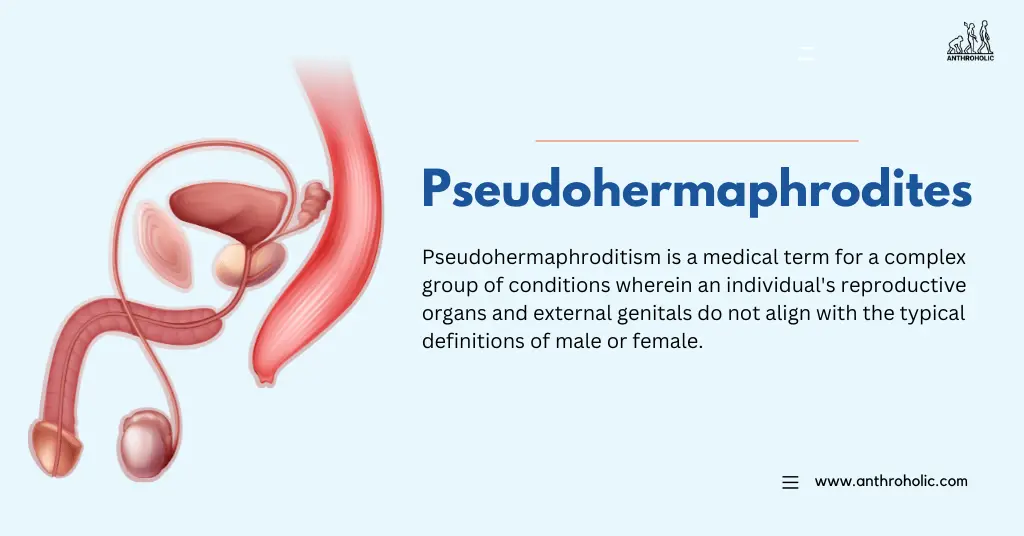AI Answer Evaluation Platform Live Now. Try Free Answer Evaluation Now
Pseudohermaphrodites
Pseudohermaphroditism is a medical term for a complex group of conditions wherein an individual’s reproductive organs and external genitals do not align with the typical definitions of male or female. These individuals have the internal reproductive organs of one sex, yet the external genitalia that resemble, to varying degrees, that of the opposite sex. Unlike true hermaphrodites, who have both ovarian and testicular tissue, pseudohermaphrodites have only the reproductive tissue of one sex.

Difference Between True Hermaphrodites and Pseudohermaphrodites
True hermaphrodites, often referred to as an individual who has ovotesticular disorder of sex development, is an extremely rare condition characterized by the presence of both testicular and ovarian tissue in the same individual. This can be within the same gonad (an ovotestis) or in separate gonads, one ovary and one testis [1].
On the other hand, pseudohermaphrodites have the internal reproductive organs of one sex and also exhibit external physical characteristics that resemble those of the opposite sex. The difference lies in the type of gonadal tissue (testes or ovaries) present. In pseudohermaphroditism, there is only one type of gonadal tissue [2].
Pseudohermaphrodites: Male vs Female
In male pseudohermaphroditism, now more commonly referred to as 46, XY DSD, individuals have a male karyotype (46, XY), testes, but their external genitalia may be ambiguous or female. This discrepancy is generally due to disorders in testosterone synthesis or action during fetal development [3].
Female pseudohermaphroditism, or 46, XX DSD, describes individuals with a female karyotype (46, XX), ovaries, but who may have ambiguous or male external genitalia. This is most often due to exposure to excess androgens during fetal development [4].
Causes of Pseudohermaphroditism
Genetic Factors
Genetic factors play a significant role in the development of pseudohermaphroditism. For example, mutations in the SRY gene, located on the Y chromosome, can prevent the development of typical male external genitalia, leading to 46,XY DSD, or male pseudohermaphroditism. Mutations in the AR gene, which codes for the androgen receptor, can result in androgen insensitivity syndrome, a form of male pseudohermaphroditism where cells cannot respond to androgens, the hormones that guide male sexual development.
Conversely, in cases of female pseudohermaphroditism (46, XX DSD), mutations in the CYP21A2 gene, which results in congenital adrenal hyperplasia, can lead to overproduction of androgens and virilization of the external genitalia [5].
Hormonal Influences
Hormones greatly influence sexual differentiation. Testosterone and anti-Müllerian hormone, secreted by the testes, promote male development, while the absence of these hormones generally leads to female development [6]. When hormonal imbalances occur, such as in androgen insensitivity syndrome or congenital adrenal hyperplasia, the external genitalia can develop in a way that does not align with the individual’s chromosomal sex.
Environmental Factors
Environmental factors that can influence the sexual development of a fetus, leading to pseudohermaphroditism, are less common but important to note. Prenatal exposure to certain synthetic chemicals, known as endocrine disruptors, may potentially interfere with the body’s endocrine system and cause disorders of sexual development [7].
Clinical Manifestations
Signs and Symptoms
The signs and symptoms of pseudohermaphrodites vary widely depending on the specific underlying condition, the individual’s chromosomal sex, and the degree of masculinization or feminization of the external genitalia.
For male pseudohermaphrodites (46, XY DSD), the manifestations might include micropenis, hypospadias (where the urethra opens on the underside of the penis), cryptorchidism (undescended testes), or a bifid scrotum (a scrotum that is divided into two parts). In some cases, the external genitalia may appear typically female.
In the case of female pseudohermaphrodites (46, XX DSD), often due to congenital adrenal hyperplasia, signs can include clitoromegaly (an enlarged clitoris), partial or complete fusion of the labia, and a urogenital sinus (a single opening for the urethra and vagina).
Health Implications
Pseudohermaphrodites can have various health implications beyond physical manifestations. For example, individuals with undiagnosed or untreated congenital adrenal hyperplasia can experience adrenal crises, which can be life-threatening without appropriate medical intervention.
The psychological impact of living with a DSD can also be significant. Many individuals experience distress, confusion, and anxiety as a result of societal and cultural pressures to conform to binary gender norms, and some may also have to grapple with issues of fertility and long-term sexual function.
It’s also crucial to note that unnecessary or non-consensual medical procedures, particularly those performed in infancy or early childhood, can have long-lasting psychological and physical consequences.
Treatment and Management
Psychosocial Support
Psychosocial support is a crucial aspect of the management of pseudohermaphrodites. Many individuals with DSDs can experience psychological distress, which may manifest as anxiety, depression, or problems with body image and self-esteem. Providing mental health support, such as counseling or psychotherapy, can significantly improve quality of life.
Additionally, support groups can provide a valuable community and safe space for individuals and families to share experiences, provide mutual support, and exchange information.
Hormonal Therapy
Hormonal therapy can be used to promote physical development that is congruent with the individual’s gender identity. For example, individuals with male pseudohermaphroditism who identify as male might be treated with testosterone to induce the development of secondary sexual characteristics such as muscle mass and body hair.
In female pseudohermaphrodites due to congenital adrenal hyperplasia, glucocorticoid therapy can be used to reduce excessive androgen production.
Surgical Interventions
Surgical interventions may be considered to align the appearance of the external genitalia with the individual’s gender identity, or to address health concerns, such as urinary tract infections in individuals with hypospadias.
However, there is ongoing debate about the timing of these interventions, particularly in infancy or early childhood, due to concerns about consent and the potential psychological impact. Decisions about surgical interventions should be made on an individual basis, with input from the affected person, their family, and a multidisciplinary team of healthcare professionals.
Recent Developments and Future Perspectives
Latest Research Findings
Research in the field of pseudohermaphroditism is ongoing and continually evolving. One recent trend has been the increasing use of whole exome and genome sequencing to identify novel genetic causes of the condition, which can improve diagnosis and understanding of the underlying pathophysiology.
Additionally, studies have begun to focus on the long-term psychological and physical outcomes of individuals with pseudohermaphroditism, with an emphasis on quality of life, mental health, and sexual function.
Ongoing Trials
As of now, several clinical trials are being conducted to investigate new diagnostic tools and therapeutic approaches for managing pseudohermaphroditism. These include novel hormonal therapies, non-invasive imaging techniques for diagnosis, and psychological interventions to improve mental health outcomes.
Future Prospects in the Field
The future of pseudohermaphroditism research and treatment lies in continued advancements in genetics, improved understanding of the psychosocial implications of the condition, and patient-centered approaches to care. There is also an increasing emphasis on establishing ethical guidelines for the treatment of young children with pseudohermaphroditism, including decisions about surgery and disclosure of the diagnosis.
Furthermore, with the increase in public awareness and understanding, it is hoped that societal acceptance of people with pseudohermaphroditism and other DSDs will increase, reducing stigma and discrimination.
References
[1] Hughes, I. A., Houk, C., Ahmed, S. F., & Lee, P. A. (2006). Consensus statement on management of intersex disorders. Archives of Disease in Childhood, 91(7), 554–563.
[2] Verkauskas, G., Jaubert, F., Lortat-Jacob, S., Malan, V., Thibaud, E., & Nihoul-Fékété, C. (2007). The long-term followup of 33 cases of true hermaphroditism: a 40-year experience with conservative gonadal surgery. The Journal of Urology, 177(3), 726–731.
[3] Ahmed, S. F., Cheng, A., Dovey, L., Hawkins, J. R., Martin, H., Rowland, J., … & Hughes, I. A. (2000). Phenotypic features, androgen receptor binding, and mutational analysis in 278 clinical cases reported as androgen insensitivity syndrome. The Journal of Clinical Endocrinology & Metabolism, 85(2), 658-665. https://doi.org/10.1210/jcem.85.2.6337
[4] Auchus, R. J. (2001). The backdoor pathway to dihydrotestosterone. Trends in Endocrinology & Metabolism, 12(9), 432-438.
[5] Speiser, P. W., Azziz, R., Baskin, L. S., Ghizzoni, L., Hensle, T. W., Merke, D. P., Meyer-Bahlburg, H. F., Miller, W. L., Montori, V. M., Oberfield, S. E., & Ritzen, M. (2010). Congenital adrenal hyperplasia due to steroid 21-hydroxylase deficiency: an Endocrine Society clinical practice guideline. The Journal of Clinical Endocrinology & Metabolism, 95(9), 4133–4160.
[6] Hiort, O. (2013). Androgens and puberty. Best Practice & Research Clinical Endocrinology & Metabolism, 27(1), 3–14.
[7] Toppari, J., Larsen, J. C., Christiansen, P., Giwercman, A., Grandjean, P., Guillette Jr, L. J., Jégou, B., Jensen, T. K., Jouannet, P., Keiding, N., Leffers, H., McLachlan, J. A., Meyer, O., Müller, J., Rajpert-De Meyts, E., Scheike, T., Sharpe, R., Sumpter, J., & Skakkebaek, N. E. (1996). Male reproductive health and environmental xenoestrogens. Environmental Health Perspectives, 104(Suppl 4), 741–803.




